Sustainability
We all hear about the need for people to change their ways and live more sustainably. But what does sustainable really mean? Ultimately it means that the way we do something should allow us to continue doing that same thing indefinitely. This means that the use of a finite resource on any large scale cannot ever be called sustainable. And that the use of a renewable resource such as water, firewood, or soil, can only be called sustainable if we use it at a slower pace than it takes for that resource to regenerate itself.
To define it in this way is to admit that almost nothing in our modern lives is sustainable, no matter what the advertisements tell us. And when nothing in our experienced lives is sustainable, it is easy to assume that the steady degradation of nature is an inevitable consequence of human culture and existence. But this is to ignore that for most of our millions of years as humans, we did not destroy ecosystems, but lived within them. Until recently the world’s tropical forests all supported relatively high densities of people, who had lived there for sometimes thousands of years, without destroying them. Fishermen did not always take until there were no fish. Some cultures did farm with the knowledge that to degrade the soil would be to imperil their children. Some of these cultures still hang on despite the relentless onslaught on their ways and on the lands that are their home.
It may not be possible for today’s huge population to live sustainably on this Earth. But this is no excuse not to take every step we can, individually and collectively, to reduce the harm we do. Every reduction in consumption, each change to a less harmful technology, each act to conserve a species or restore a habitat is a movement in the right direction. We must take these steps knowing that they only buy us a little time, a bit more time to find ways to take the next steps, and the next, towards learning again how to live consciously within the web of live.
We are not claiming to have answers, or that we ourselves live in a sustainable way. We are, though, committed to constantly enquiring into how we can move away from destruction and toward regeneration, and to taking what steps we can as they become clear. We are also clear that changes at the individual level, while commendable, do little to help a biosphere in deep distress. We must also actively engage with the wider issues that are bringing about the impoverishment of life itself. This may be through education, it may be actively working for greater social and environmental justice, it may be through protecting threatened land and the life it contains, but given the urgency of our times, solar panels are not enough.
Marudam Farm
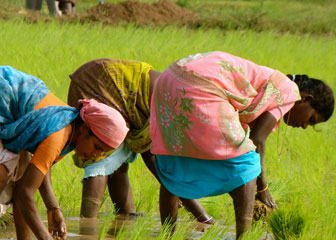 Marudam farm consist of almost ten acres of land about 6km from Thiruvannamalai. We came to the land in 2009. It was agricultural land that had suffered many years of chemical farming, before passing into the hands of a property developer for a couple of years. Much of it had been bulldozed in anticipation of its conversion to building plots, compacting the soil and destroying the trees on the field boundaries. Now it is recovering. A poly-culture is evolving, of fruits and animals, people and plants, birds and bees. There are about five acres of agricultural fields and vegetable gardens. The rest of the land is a mosaic of left alone forest patches, playgrounds, access roads, and the school and residential buildings, all interspersed with fruit and forest trees.
Marudam farm consist of almost ten acres of land about 6km from Thiruvannamalai. We came to the land in 2009. It was agricultural land that had suffered many years of chemical farming, before passing into the hands of a property developer for a couple of years. Much of it had been bulldozed in anticipation of its conversion to building plots, compacting the soil and destroying the trees on the field boundaries. Now it is recovering. A poly-culture is evolving, of fruits and animals, people and plants, birds and bees. There are about five acres of agricultural fields and vegetable gardens. The rest of the land is a mosaic of left alone forest patches, playgrounds, access roads, and the school and residential buildings, all interspersed with fruit and forest trees.
What do we grow, and How?
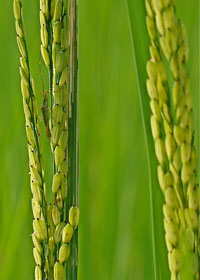 Each day we provide breakfast to all the workers of the Forest way, as well as lunch for the children and teachers of the school. The aim of the farm is to be able to provide all of this food organically. This means we must grow a range of grains, pulses, oilseeds, fruit and vegetables throughout the year, and it is not as easy as one might think. The grains we grow are chiefly rice, followed by a variety of millets and sorghum. For oil we have coconuts, sesame and peanuts, whilst our pulses are moong and urad dhal, cowpea, and tur dhal. We have planted over 30 types of fruit trees and bushes. Vegetables are a challenge, particularly in the tropical summers, when only brinjal, ladies fingers and cluster beans are really happy. In the cooler months we are able to grow a wonderful variety of salads, pumpkins, beans, gourds, sweet potatoes, yams, amaranths, leaf vegetables, tomatoes and herbs. In all we grow, we try to play a role in preserving traditional varieties of crops that are fast disappearing.
Each day we provide breakfast to all the workers of the Forest way, as well as lunch for the children and teachers of the school. The aim of the farm is to be able to provide all of this food organically. This means we must grow a range of grains, pulses, oilseeds, fruit and vegetables throughout the year, and it is not as easy as one might think. The grains we grow are chiefly rice, followed by a variety of millets and sorghum. For oil we have coconuts, sesame and peanuts, whilst our pulses are moong and urad dhal, cowpea, and tur dhal. We have planted over 30 types of fruit trees and bushes. Vegetables are a challenge, particularly in the tropical summers, when only brinjal, ladies fingers and cluster beans are really happy. In the cooler months we are able to grow a wonderful variety of salads, pumpkins, beans, gourds, sweet potatoes, yams, amaranths, leaf vegetables, tomatoes and herbs. In all we grow, we try to play a role in preserving traditional varieties of crops that are fast disappearing.
 Our aim on the farm is to operate without external inputs. We have not achieved this as yet. We still bring in cow manure for the fields, and some extra food for our own cows. But this is reducing each year as the fertility and structure of the soil rebuild. We help this process by rotating the crops with green manures, which are plowed back into the soil, and by stimulated the micro-fauna with preparations such as panchakavya.
Our aim on the farm is to operate without external inputs. We have not achieved this as yet. We still bring in cow manure for the fields, and some extra food for our own cows. But this is reducing each year as the fertility and structure of the soil rebuild. We help this process by rotating the crops with green manures, which are plowed back into the soil, and by stimulated the micro-fauna with preparations such as panchakavya.
Over the coming years we aim to work towards even more natural ways of farming, specifically to stop plowing the land for the crops. Turning the soil to remove weeds exposes the soil to sun and rain, which compact it. It also speeds the breakdown of organic matter, thus reducing the humus in the soil, and kills vital earthworms and other soil life. On the other hand, with natural farming, the topsoil builds year upon year, as does the life and fertility of the farm. Already the vegetable gardens are largely under a no-dig system and the texture of the soil has changed completely. In the coming year we will start to experiment slowly with the fields.
We are still a long way from our vision of full self-sufficiency, but yields are increasing year upon year as the fertility improves. Already this year the school will have no need to buy rice or oils, which is a great feeling. Fruit trees planted three years ago are starting to fruit, and our own understanding is growing.
Marudam Farm has two water sources. One is a bore-well, 40m deep, which supplies an overhead tank through a solar pump. From this tank all the houses, the school, the vegetable gardens and orchards are supplied. The crops are irrigated from an open well with a 3hp pump connected to the electric grid. This open well also doubles as the Marudam swimming hole.
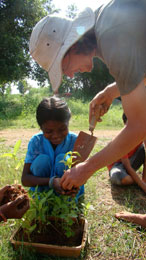 In addition to the countless insects, the many birds, the snakes and lizards, the five human families, four dogs and two cats, the farm is home to seven cows. Four of these are oxen, who are used to plow the land and pull the bullock cart. Two are cows who refuse to get pregnant, and one is a young bull. Apart from the work they do on the farm, their urine is used in various plant medicines, natural pest repellents and growth promoters, and their dung powers our bio-gas plant before it goes back to the fields.
In addition to the countless insects, the many birds, the snakes and lizards, the five human families, four dogs and two cats, the farm is home to seven cows. Four of these are oxen, who are used to plow the land and pull the bullock cart. Two are cows who refuse to get pregnant, and one is a young bull. Apart from the work they do on the farm, their urine is used in various plant medicines, natural pest repellents and growth promoters, and their dung powers our bio-gas plant before it goes back to the fields.
Finally, the connection of the children to the life of the farm is a crucial part of the picture. Each of the children spend regular gardening time throughout the year, as well as taking part in the big events like rice planting and harvest. It is our conviction that growing food is an empowering act. Doing it naturally is an enriching one, and eating that food is a joy.
Eco Construction
As the different areas of the project have grown, the need for various buildings has meant that design and construction have become an integral, often challenging and very rewarding part of our work. Beyond the individual design needs of each space, we have tried to make each of our buildings sit harmoniously within the landscape rather than imposing themselves upon it, and we have worked with a variety of construction methods to limit the ecological footprint of the construction and functioning of the building.
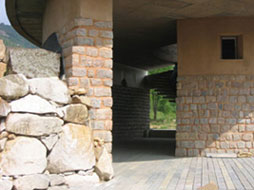 For the interpretation centre in the Forest Park we used a lime mortar for the stone walls. We used lime made locally in homemade charcoal kilns. This was then ground by our bullocks with a mix of Terminalia chebula seeds fermented with jaggery. This traditional recipe adds to the strength and elasticity of the lime. The stone for the walls was cut on site and the cooling effect of the thick stone walls is enhanced by the earth berms that add to the thermal mass. There will also be a full roof garden, further cooling the space.
For the interpretation centre in the Forest Park we used a lime mortar for the stone walls. We used lime made locally in homemade charcoal kilns. This was then ground by our bullocks with a mix of Terminalia chebula seeds fermented with jaggery. This traditional recipe adds to the strength and elasticity of the lime. The stone for the walls was cut on site and the cooling effect of the thick stone walls is enhanced by the earth berms that add to the thermal mass. There will also be a full roof garden, further cooling the space.
For the various houses at Marudam farm we have played with a number of techniques. The volunteer accommodation and Govinda and Leela’s house uses pole roof constructions sitting on granite pillars. The roofs are then thatched and the downstairs walls are made of that finest and most ancient of building materials-mud. We have played with different mixes, adding various proportions of clay, sand straw, cow-dung or just pure mud. Termites can be an issue, as they find the walls quite welcoming. This means that the walls must stop short of the tops of the pillars, so that the termites cannot access the eminently edible roofs. One could lift the mud walls up on a plinth beam to stop the termites entering, but ours are mud all the way. The floors are mud too, meaning that if we leave the house, in a few short years the roof will rot and collapse, the rain will wash away the walls and the place will be fertile soil once more. It’s a nice thought.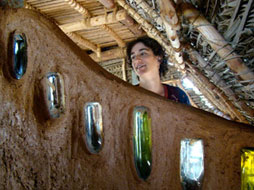
Using mud in a different way is Ajay and Maitrey’s house. The rammed earth walls there require a greater level of technical skill to complete, but the finished wall has an exquisite look and requires no maintenance. Soil is mixed with sand and a small amount of lime (about 5%) and then compressed manually inside a pre-made shuttering. So the house rises in sections of these earth panels rather than the walls coming up evenly.
We were very constrained in the school construction by unimaginative regulations on the part of the education department, who insisted on reinforced concrete roofs. We used cavity walls to keep the buildings naturally cool, and formulated a mud/cement mortar that reduced the cement content by half. All the wood used was old, salvaged wood, but overall the construction methods are fairly conventional.
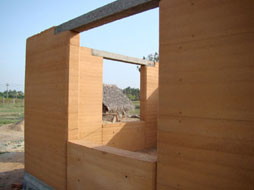 We do not claim that any of the buildings are truly sustainable. We have used cement and steel in varying quantities in the different buildings, and these are in no way sustainable in any quantity. The poles used for the house roofs are grown as a plantation crop, with a lot of water. The bamboo used in Arun and Poornima’s house is better, but requires treatment if it’s not to be devoured by borers. Traditional village houses of mud and thatch are typically very small. The size is probably governed by how much thatch one family can cut every few years when it needs replacing, or how much roof poles are available locally when everyone builds in this way. There is more thatch grass available these days because the villagers are shifting to concrete roofs. It can be difficult to speak of sustainability living as we do in the midst of an utterly unsustainable culture. We may use materials (such as salvaged wood, discarded bottles, used tires) and tell ourselves that we have reduced our impact, but this matters little in the bigger picture. It has been good to familiarise ourselves with some of the possible techniques so that we may share them with others, but it is only a small step in the right direction.
We do not claim that any of the buildings are truly sustainable. We have used cement and steel in varying quantities in the different buildings, and these are in no way sustainable in any quantity. The poles used for the house roofs are grown as a plantation crop, with a lot of water. The bamboo used in Arun and Poornima’s house is better, but requires treatment if it’s not to be devoured by borers. Traditional village houses of mud and thatch are typically very small. The size is probably governed by how much thatch one family can cut every few years when it needs replacing, or how much roof poles are available locally when everyone builds in this way. There is more thatch grass available these days because the villagers are shifting to concrete roofs. It can be difficult to speak of sustainability living as we do in the midst of an utterly unsustainable culture. We may use materials (such as salvaged wood, discarded bottles, used tires) and tell ourselves that we have reduced our impact, but this matters little in the bigger picture. It has been good to familiarise ourselves with some of the possible techniques so that we may share them with others, but it is only a small step in the right direction.
